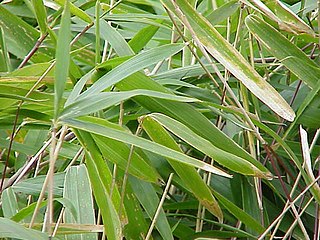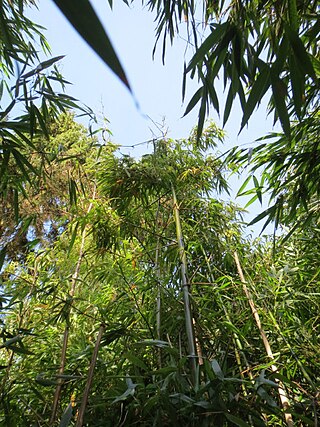
Pleioblastus is an East Asian genus of monopodial bamboos in the grass family Poaceae. They are native to China and Japan, and naturalized in scattered places in Korea, Europe, New Zealand, and the Western Hemisphere.

Indocalamus is a genus of about 35 species of flowering plants in the grass family (Poaceae), native to China, Vietnam and Japan. They are quite small evergreen bamboos normally up to 2 m (6.6 ft) in height, initially forming clumps and then spreading to form larger thickets. They have thick, glossy leaves. Ruo leaves use to wrap foods like rice during dragon boat festival, originate in fujian refer to Indocalamus longiauritusoriginally but now are nonspecific to just about any leaf wrap.

Pseudosasa is a genus of East Asian bamboo in the grass family.

Sasaella is a genus of Japanese bamboo in the grass family.
- Sasaella bitchuensis(Makino) Koidz – southern Honshu
- Sasaella caudiceps(Koidz.) Koidz. – Honshu
- Sasaella hidaensis(Makino) Makino, Hishu zasa – Honshu, Shikoku
- Sasaella hisauchii(Makino) Makino, Hime suzu – Honshu, Shikoku
- Sasaella kogasensis(Nakai) Nakai ex Koidz, Kogashi azuma zasa – Hokkaido, Honshu
- Sasaella leucorhoda(Koidz.) Koidz. – Honshu
- Sasaella masamuneana(Makino) Hatsushima & Muroi, Genkei chiku – Japan
- Sasaella ramosa(Makino) Makino, Azuma zasa – Japan; naturalized in Great Britain + New Zealand
- Sasaella sadoensis(Makino ex Koidz.) Sad.Suzuki – Honshu
- Sasaella sawadae(Makino) Makino ex Koidzum – Honshu
- Sasaella shiobarensis(Nakai) Koidz. – Honshu

Shibataea is a genus of Chinese bamboos in the grass family.

Sinobambusa is a genus of East Asian bamboo in the grass family. It is native to China and Vietnam. Sinobambusa tootsik also occurs in Japan, having been introduced there during the Tang dynasty (618–907).
- Sinobambusa baccanensisT.Q.Nguyen – Vietnam
- Sinobambusa farinosa(McClure) T.H.Wen – Fujian, Guangdong, Guangxi, Jiangxi, Zhejiang
- Sinobambusa henryi(McClure) C.D.Chu & C.S.Chao – Guangdong, Guangxi
- Sinobambusa humilaMcClure – Guangdong
- Sinobambusa incanaT.H.Wen – Guangdong
- Sinobambusa intermediaMcClure – Fujian, Guangdong, Guangxi, Sichuan, Yunnan
- Sinobambusa nephroauritaC.D.Chu & C.S.Chao – Guangdong, Guangxi, Sichuan
- Sinobambusa rubroligulaMcClure – Guangdong, Guangxi, Hainan
- Sinobambusa sat(Balansa) C.S.Chao & Renvoize – Vietnam
- Sinobambusa scabridaT.H.Wen – Guangxi
- Sinobambusa solearis(McClure) T.Q.Nguyen – Vietnam
- Sinobambusa tootsik(Makino) Makino ex Nakai – Fujian, Guangdong, Guangxi, Vietnam; naturalized in Japan including Ryukyu Islands
- Sinobambusa yixingensisC.S.Chao & K.S.Xiao – Jiangsu

Thamnocalamus is a genus of clumping bamboo in the grass family. These species are found from the Himalayas as well as Madagascar and Southern Africa.

Adenophora is a genus of flowering plants in the family Campanulaceae, the bellflowers. Plants of this genus are known commonly as ladybells. Most are native to eastern Asia, with a few in Europe. Many are endemic to either China or Siberia.

Yushania is a genus of bamboo in the grass family.

Osmanthus is a genus of about 30 species of flowering plants in the family Oleaceae. Most of the species are native to eastern Asia with a few species from the Caucasus, New Caledonia, and Sumatra. Osmanthus has been known in China since ancient times with the earliest writings coming from the Warring States period; the book Sea and Mountain. South Mountain states: "Zhaoyao Mountain had a lot of Osmanthus".

Arundinarieae is a tribe of bamboo in the grass family (Poaceae) containing a single subtribe, Arundinariinae, and 31 genera. These woody bamboos occur in areas with warm temperate climates in southeastern North America, Subsaharan Africa, South Asia and East Asia. The tribe forms a lineage independent of the tropical woody bamboos (Bambuseae) and the tropical herbaceous bamboos (Olyreae).

Acidosasa is a genus of East Asian bamboo in the grass family.

Fargesia is a genus of flowering plants in the grass family. These bamboos are native primarily to China, with a few species in Vietnam and in the eastern Himalayas. Some species are cultivated as ornamentals, with common names including umbrella bamboo and fountain bamboo.

Oligostachyum is a genus of bamboo in the grass family, native to coastal China.
Henryi, a new Latin adjective used for any of several naturalists named Henry, may refer to:

The Bambouseraie de Prafrance is a private botanical garden specializing in bamboos, located in Générargues, near Anduze, Gard, Languedoc-Roussillon, France. It is open daily in the warmer months; an admission fee is charged.

Mosla is a genus of plants in the family Lamiaceae, first described as a genus in 1875. It is native to eastern Asia, the Himalayas, and southeastern Asia.
- Mosla bracteataDoan ex Suddee & A.J.Paton - Vietnam
- Mosla cavalerieiH.Lév.- Vietnam, Guangdong, Guangxi, Guizhou, Hubei, Jiangxi, Sichuan, Yunnan, Zhejiang
- Mosla chinensisMaxim. - Vietnam, Korea, Japan, Anhui, Fujian, Guangdong, Guangxi, Guizhou, Hubei, Hunan, Jiangsu, Jiangxi, Shandong, Sichuan, Taiwan, Zhejiang
- Mosla coreanaH.Lév. - Korea
- Mosla dianthera(Buch.-Ham. ex Roxb.) Maxim. - China, Japan, Korea, Ryukyu Islands, Kuril Islands, Primorye, Caucasus, Himalayas, Myanmar, Vietnam, Philippines, Sumatra
- Mosla exfoliata(C.Y.Wu) C.Y.Wu & H.W.Li - Sichuan
- Mosla hangchouensisMatsuda - Zhejiang
- Mosla japonica(Benth. ex Oliv.) Maxim. - Japan, Korea, Ryukyu Islands
- Mosla longibracteata(C.Y.Wu & S.J.Hsuan) C.Y.Wu & H.W.Li - Guangxi, Zhejiang
- Mosla longispica(C.Y.Wu) C.Y.Wu & H.W.Li - Jiangxi
- Mosla pauciflora(C.Y.Wu) C.Y.Wu & H.W.Li - Guizhou, Hubei, Sichuan
- Mosla punctulataNakai - Korea, Taiwan, Japan, China
- Mosla scabra(Thunb.) C.Y.Wu & H.W.Li - Vietnam, Korea, Japan, Ryukyu Islands, Anhui, Fujian, Gansu, Guangdong, Guangxi, Henan, Hubei, Hunan, Jiangsu, Jiangxi, Liaoning, Shaanxi, Sichuan, Taiwan, Zhejiang
- Mosla soochouensisMatsuda - Anhui, Jiangsu, Jiangxi, Zhejiang
- Mosla tamdaoensisPhuong - Vietnam
Yushania elegans is a species of bamboo. It is found in India and Indo-China.

Pleioblastus fortunei is a species of bamboo in the family Poaceae. It is native to central and southern Japan, and has been introduced to southeast China, the North and South Islands of New Zealand, Maryland, Virginia, and the District of Columbia in the United States, Columbia, South East Brazil and India. It is hardy to −10 °F (−23 °C); USDA Hardiness zone 6a. It is an invasive species, escaping from cultivation and difficult to control, even surviving mowing. As its synonym Pleioblastus variegatus, dwarf white-striped bamboo, a variegated morph, has gained the Royal Horticultural Society's Award of Garden Merit.

















